并购目标选择-文献综述
- 格式:ppt
- 大小:1.22 MB
- 文档页数:25
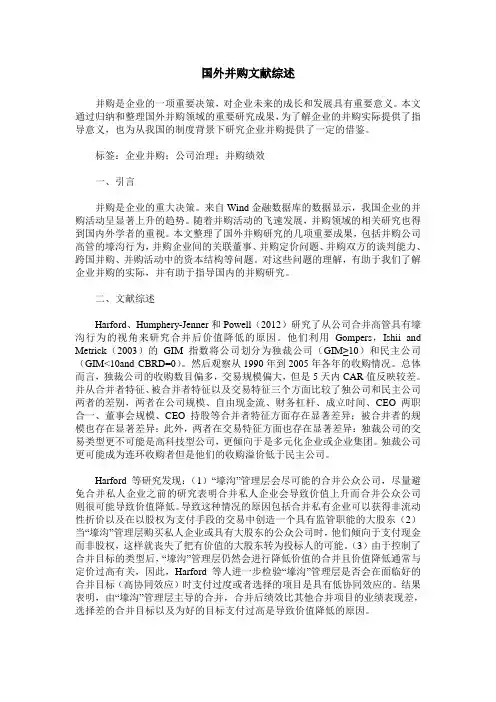
国外并购文献综述并购是企业的一项重要决策,对企业未来的成长和发展具有重要意义。
本文通过归纳和整理国外并购领域的重要研究成果,为了解企业的并购实际提供了指导意义,也为从我国的制度背景下研究企业并购提供了一定的借鉴。
标签:企业并购;公司治理;并购绩效一、引言并购是企业的重大决策。
来自Wind金融数据库的数据显示,我国企业的并购活动呈显著上升的趋势。
随着并购活动的飞速发展,并购领域的相关研究也得到国内外学者的重视。
本文整理了国外并购研究的几项重要成果,包括并购公司高管的壕沟行为,并购企业间的关联董事、并购定价问题、并购双方的谈判能力、跨国并购、并购活动中的资本结构等问题。
对这些问题的理解,有助于我们了解企业并购的实际,并有助于指导国内的并购研究。
二、文献综述Harford、Humphery-Jenner和Powell(2012)研究了从公司合并高管具有壕沟行为的视角来研究合并后价值降低的原因。
他们利用Gompers,Ishii and Metrick(2003)的GIM指数将公司划分为独裁公司(GIM≥10)和民主公司(GIM<10and CBRD=0)。
然后观察从1990年到2005年各年的收购情况。
总体而言,独裁公司的收购数目偏多,交易规模偏大,但是5天内CAR值反映较差。
并从合并者特征、被合并者特征以及交易特征三个方面比较了独公司和民主公司两者的差别,两者在公司规模、自由现金流、财务杠杆、成立时间、CEO两职合一、董事会规模、CEO持股等合并者特征方面存在显著差异;被合并者的规模也存在显著差异;此外,两者在交易特征方面也存在显著差异:独裁公司的交易类型更不可能是高科技型公司,更倾向于是多元化企业或企业集团。
独裁公司更可能成为连环收购者但是他们的收购溢价低于民主公司。
Harford等研究发现:(1)“壕沟”管理层会尽可能的合并公众公司,尽量避免合并私人企业之前的研究表明合并私人企业会导致价值上升而合并公众公司则很可能导致价值降低。
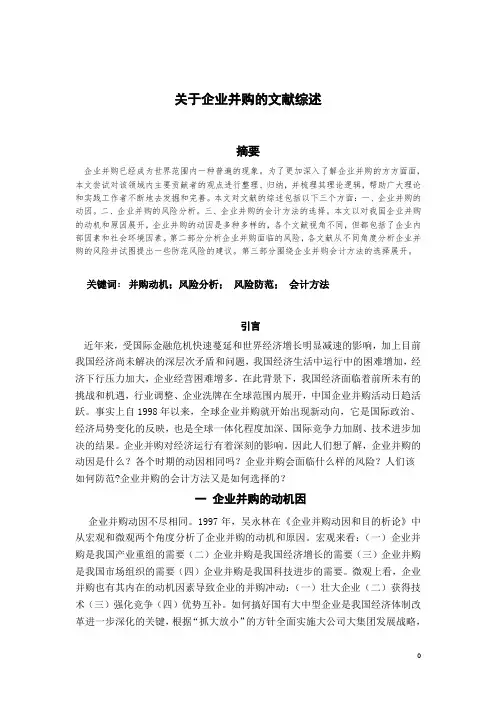
关于企业并购的文献综述摘要企业并购已经成为世界范围内一种普遍的现象。
为了更加深入了解企业并购的方方面面,本文尝试对该领域内主要贡献者的观点进行整理、归纳,并梳理其理论逻辑,帮助广大理论和实践工作者不断地去发掘和完善。
本文对文献的综述包括以下三个方面:一、企业并购的动因。
二、企业并购的风险分析。
三、企业并购的会计方法的选择。
本文以对我国企业并购的动机和原因展开,企业并购的动因是多种多样的,各个文献视角不同,但都包括了企业内部因素和社会环境因素。
第二部分分析企业并购面临的风险,各文献从不同角度分析企业并购的风险并试图提出一些防范风险的建议。
第三部分围绕企业并购会计方法的选择展开。
关键词:并购动机;风险分析;风险防范;会计方法引言近年来,受国际金融危机快速蔓延和世界经济增长明显减速的影响,加上目前我国经济尚未解决的深层次矛盾和问题,我国经济生活中运行中的困难增加,经济下行压力加大,企业经营困难增多。
在此背景下,我国经济面临着前所未有的挑战和机遇,行业调整、企业洗牌在全球范围内展开,中国企业并购活动日趋活跃。
事实上自1998年以来,全球企业并购就开始出现新动向,它是国际政治、经济局势变化的反映,也是全球一体化程度加深、国际竞争力加剧、技术进步加决的结果。
企业并购对经济运行有着深刻的影响。
因此人们想了解,企业并购的动因是什么?各个时期的动因相同吗?企业并购会面临什么样的风险?人们该如何防范?企业并购的会计方法又是如何选择的?一企业并购的动机因企业并购动因不尽相同。
1997年,吴永林在《企业并购动因和目的析论》中从宏观和微观两个角度分析了企业并购的动机和原因。
宏观来看:(一)企业并购是我国产业重组的需要(二)企业并购是我国经济增长的需要(三)企业并购是我国市场组织的需要(四)企业并购是我国科技进步的需要。
微观上看,企业并购也有其内在的动机因素导致企业的并购冲动:(一)壮大企业(二)获得技术(三)强化竞争(四)优势互补。
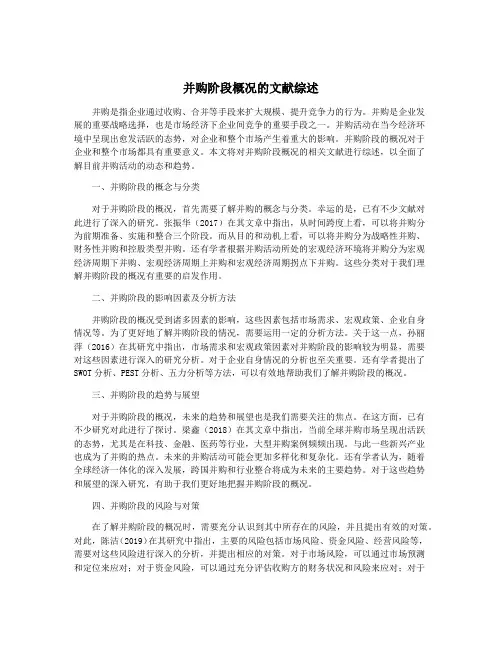
并购阶段概况的文献综述并购是指企业通过收购、合并等手段来扩大规模、提升竞争力的行为。
并购是企业发展的重要战略选择,也是市场经济下企业间竞争的重要手段之一。
并购活动在当今经济环境中呈现出愈发活跃的态势,对企业和整个市场产生着重大的影响。
并购阶段的概况对于企业和整个市场都具有重要意义。
本文将对并购阶段概况的相关文献进行综述,以全面了解目前并购活动的动态和趋势。
一、并购阶段的概念与分类对于并购阶段的概况,首先需要了解并购的概念与分类。
幸运的是,已有不少文献对此进行了深入的研究。
张振华(2017)在其文章中指出,从时间跨度上看,可以将并购分为前期准备、实施和整合三个阶段。
而从目的和动机上看,可以将并购分为战略性并购、财务性并购和控股类型并购。
还有学者根据并购活动所处的宏观经济环境将并购分为宏观经济周期下并购、宏观经济周期上并购和宏观经济周期拐点下并购。
这些分类对于我们理解并购阶段的概况有重要的启发作用。
二、并购阶段的影响因素及分析方法并购阶段的概况受到诸多因素的影响,这些因素包括市场需求、宏观政策、企业自身情况等。
为了更好地了解并购阶段的情况,需要运用一定的分析方法。
关于这一点,孙丽萍(2016)在其研究中指出,市场需求和宏观政策因素对并购阶段的影响较为明显,需要对这些因素进行深入的研究分析。
对于企业自身情况的分析也至关重要。
还有学者提出了SWOT分析、PEST分析、五力分析等方法,可以有效地帮助我们了解并购阶段的概况。
三、并购阶段的趋势与展望对于并购阶段的概况,未来的趋势和展望也是我们需要关注的焦点。
在这方面,已有不少研究对此进行了探讨。
梁鑫(2018)在其文章中指出,当前全球并购市场呈现出活跃的态势,尤其是在科技、金融、医药等行业,大型并购案例频频出现。
与此一些新兴产业也成为了并购的热点。
未来的并购活动可能会更加多样化和复杂化。
还有学者认为,随着全球经济一体化的深入发展,跨国并购和行业整合将成为未来的主要趋势。
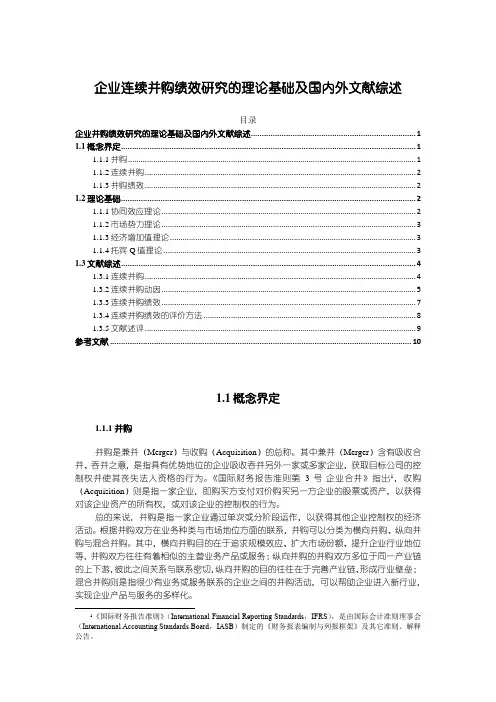
企业连续并购绩效研究的理论基础及国内外文献综述目录企业并购绩效研究的理论基础及国内外文献综述 (1)1.1概念界定 (1)1.1.1并购 (1)1.1.2连续并购 (2)1.1.3并购绩效 (2)1.2理论基础 (2)1.1.1协同效应理论 (2)1.1.2市场势力理论 (3)1.1.3经济增加值理论 (3)1.1.4托宾Q值理论 (3)1.3文献综述 (4)1.3.1连续并购 (4)1.3.2连续并购动因 (5)1.3.3连续并购绩效 (7)1.3.4连续并购绩效的评价方法 (8)1.3.5文献述评 (9)参考文献 (10)1.1概念界定1.1.1并购并购是兼并(Merger)与收购(Acquisition)的总称。
其中兼并(Merger)含有吸收合并、吞并之意,是指具有优势地位的企业吸收吞并另外一家或多家企业,获取目标公司的控制权并使其丧失法人资格的行为。
《国际财务报告准则第3号-企业合并》指出1,收购(Acquisition)则是指一家企业,即购买方支付对价购买另一方企业的股票或资产,以获得对该企业资产的所有权,或对该企业的控制权的行为。
总的来说,并购是指一家企业通过单次或分阶段运作,以获得其他企业控制权的经济活动。
根据并购双方在业务种类与市场地位方面的联系,并购可以分类为横向并购、纵向并购与混合并购。
其中,横向并购目的在于追求规模效应、扩大市场份额、提升企业行业地位等,并购双方往往有着相似的主营业务产品或服务;纵向并购的并购双方多位于同一产业链的上下游,彼此之间关系与联系密切,纵向并购的目的往往在于完善产业链、形成行业壁垒;混合并购则是指很少有业务或服务联系的企业之间的并购活动,可以帮助企业进入新行业,实现企业产品与服务的多样化。
1《国际财务报告准则》(International Financial Reporting Standards,IFRS),是由国际会计准则理事会(International Accounting Standards Board,IASB)制定的《财务报表编制与列报框架》及其它准则、解释公告。
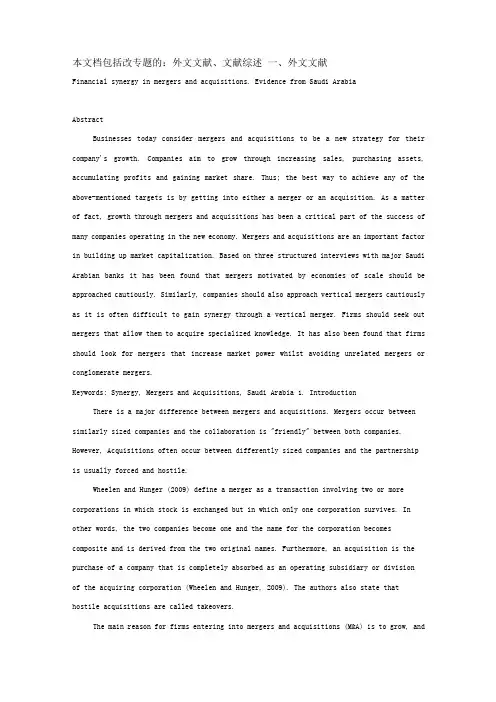
本文档包括改专题的:外文文献、文献综述一、外文文献Financial synergy in mergers and acquisitions. Evidence from Saudi ArabiaAbstractBusinesses today consider mergers and acquisitions to be a new strategy for their company's growth. Companies aim to grow through increasing sales, purchasing assets, accumulating profits and gaining market share. Thus; the best way to achieve any of the above-mentioned targets is by getting into either a merger or an acquisition. As a matter of fact, growth through mergers and acquisitions has been a critical part of the success of many companies operating in the new economy. Mergers and acquisitions are an important factor in building up market capitalization. Based on three structured interviews with major Saudi Arabian banks it has been found that mergers motivated by economies of scale should be approached cautiously. Similarly, companies should also approach vertical mergers cautiously as it is often difficult to gain synergy through a vertical merger. Firms should seek out mergers that allow them to acquire specialized knowledge. It has also been found that firms should look for mergers that increase market power whilst avoiding unrelated mergers or conglomerate mergers.Keywords: Synergy, Mergers and Acquisitions, Saudi Arabia 1. IntroductionThere is a major difference between mergers and acquisitions. Mergers occur between similarly sized companies and the collaboration is "friendly" between both companies. However, Acquisitions often occur between differently sized companies and the partnership is usually forced and hostile.Wheelen and Hunger (2009) define a merger as a transaction involving two or more corporations in which stock is exchanged but in which only one corporation survives. In other words, the two companies become one and the name for the corporation becomes composite and is derived from the two original names. Furthermore, an acquisition is the purchase of a company that is completely absorbed as an operating subsidiary or divisionof the acquiring corporation (Wheelen and Hunger, 2009). The authors also state thathostile acquisitions are called takeovers.The main reason for firms entering into mergers and acquisitions (M&A) is to grow, andcompanies grow to survive (Akinbuli, 201 2). Growth strategies expand the company's activities and add to its value since larger firm have more bargaining power than smaller ones. A firm sustaining growth will always have more opportunities for advancement, promotions and more jobs to offer people (Wheelen and Hunger, 2009). In general, mergers and different types of acquisitions are performed in the hope of realizing an economic gain. For such a business deal to take place, the two firms involved must be worth more together than each was apart.A few of the prospective advantages of M&A include achieving economies of scale, combining complementary resources, garnering tax advantages, and eliminating inefficiencies. Other reasons for considering growth through acquisitions contain obtaining proprietary rights to products or services, increasing market power by purchasing competitors, shoring up weaknesses in key business areas, penetrating new geographic regions, or providing managers with new opportunities for career growth and advancement (Brown, 2005).Many firms choose M&A as a tool to expand into a new market or new area of expertise since it is quicker and cheaper than taking the risk alone. Furthermore, M&A happen when senior executives feel enthusiastic and excited about a potential deal ; the idea of successfully pursuing and taking over another company before the company s competitors are able to do so. Competition in a growing industry drives firms to acquire others. In fact, a successful merger between companies increases benefits for the entire corporation.However, failures also occur in M&A as indicated by Haberbserg and Rieple (2001) and Akinbuli (2012). They showed that 50% of acquisitions are unsuccessful; they increase market power but do not necessarily increase profits. Brown (2005) explains the reasons for the high failure rate of M&A as follows:(a)Over-optimistic assessment of economies of scale. Economies of scale are usually achieved at certain business size. However, expansion beyond the optimum level results in disproportionate cost disadvantages that lead to various diseconomies of scale.(b)Inadequate preliminary investigation combined with an inability to implement the amalgamation efficiently. Resistance to change and the inability for the acquired company to manage change well is a main reason for failure due to the resistance of the employees and management of both companies involved.(c)Insufficient appreciation of the personnel problems, which will arise, is due mainly to the differing organizational cultures in each company.(d)Dominance of subjective factors such as the status of the respective boards of directors.Therefore, drafting careful plans before and after the merger is a necessity that should not be overlooked. Some companies find the solution in hiring a change manager who will add value and better manage the transition of the "marriage between both companies" (Brown, 2005).2.Synergy in M&A and financial synergyThis section discusses the literature review in order to identify the importance of acquiring financial synergy in the M&A.2.1Synergy in M&ASynergy, as defined in the business dictionary, is the state in which two or more agents, entities, factors, processes, substances, or systems work together in a particularly fruitful way that produces an effect greater than the sum of their individual effects. Synergy is the magic force that allows for enhanced cost efficiencies of the new business. Synergy takes the form of revenue enhancement and cost savings (Mergers and acquisitions: Definition, n.d.).Synergy is also expressed as an increase in the value of assets as a result of their combination. Expected synergy is the justification behind most business mergers. For example, the 2002 combination of Hewlett-Packard and Compaq was designed to reduce expenses and capitalize on combining Hewlett-Packard's reputation for quality with Compaq's impressive distribution system (Synergy Business Definition, n.d.).Through research it has been noted that synergy is the concept that two businesses will generate greater profits together than they could separately (Wheelen and Hunger, 2009). Synergy is said to exist for a divisional corporation if the return on investment of each division is greater than what the return would be if each division were an independent business (Wheelen and Hunger, 2009). In order to succeed cooperation between the partners is the basic ingredient for achieving growth through synergy (Rahatullah, 201 0). This requires partners to build trust, commitment, and secure consensus, to achieve their targets (Gronroos, 1997; Ring and Van-de-Ven, 1994).Synergy can take several forms. According to Goold and Campbell (1 998) synergy is demonstrated in six ways: benefiting from knowledge or skills, coordinated strategies,shared tangible resources, economies of scale, gaining bargaining power over suppliers and creating new products or services.M8<A result in the creation of synergies, the sharing of manufacturing facilities, software systems and distribution processes. This type of synergy is referred to as operational synergy and is seen mostly in manufacturing industries. Another motive for forming an acquisition is gaining greater financial strength by purchasing a competitor, which increases market share. The aim of mergers and acquisitions is to achieve improvement for both companies and produce efficiency in most of the company's operations. (Haberberg and Rieple, 2001).However, Brown (2005) summarizes the sources of synergy that result from M8<A underthe following headlines:1.Operating economies which include:(a)Economies of scale: Horizontal mergers (acquisition of a company in a similarline of business) are often claimed to reduce costs and therefore increase profits due to economies of scale. These can occur in the production, marketing or finance divisions.Note that these gains are not expected automatically and diseconomies of scale may also be experienced. These benefits are sometimes also claimed for conglomerate mergers(acquisition of companies in unrelated areas of business) in financial and marketingcosts.(b)Economies of vertical integration: Some acquisitions involve buying out other companies in the same production chain. For example, a manufacturer buys out a rawmaterial supplier or a retailer. This can increase profits through eliminating the middleman in the supply chain.(c)Complementary resources: It is sometimes argued that by combining the strengths of two companies a synergistic result can be obtained. For example, combining a company specializing in research and development with a company strong in the marketing area could lead to gains. Combining the expertise of both firms would benefit each company through the gained knowledge and skills that individually they lack.(d)Elimination of inefficiency: If either of the two companies had been badly managed; its performance and hence its value can be improved by the elimination of inefficiencies through M&A, Improvements could be obtained in the areas of production, marketing and finance.2.Market power; Horizontal mergers may enable the firm to obtain a degree of monopoly power which could increase its profitability. Coordinated strategies between both companies will lead the entire organization in gaining competitive advantage. Gaining bargaining power over suppliers is realized since the company is larger in size after the merger.3.Financial gains; Companies with large amounts of surplus cash may see the acquisition of other companies as the best application for these funds. Shared tangible resources such as sharing a bigger building, more office supplies, equipment, manufacturing facilities and research and design labs will also lead to a reduction in costs translated into better financial performance. McNeil (2012) identifies that the shareholders of a business under M&A process may benefit from the sale of their stocks, this is especially true if the M&A is with a better, bigger and more reputable prospective partner.4.Others; such as surplus management talent, meaning that companies with highly skilled managers can make use of their qualified personnel only if they have problems to solve. The acquisition of inefficient companies allows for maximum utilization of skilled managers. Incorporating the efforts of both management teams will drive the creation of innovative products or services.The synergy factor prevails in the M&A when the firms produce a greater return than the two individual firms owing to reasons such as improvements in efficiency and an increase in market power for the merged or acquired firms (Berkovitch and Narayana, 1993).2.2Financial synergyAs defined by Knoll (2008), financial synergies are performance advantages gained by controlling financial resources across businesses of firms. There exist four types of financial synergies, which are:1.Reduction of corporate risk: Reduction of corporate risk is increasing the risk capacity of the overall firm, which means the ability of the firm to bear more risk. Meaning that by increasing the risk capacity the shareholders will invest more in the company and the firm will gain benefits such as coinsurance effects.2.Establishment of internal capital market: Establishing internal capital gains means that the firm will decrease its financing costs and will increase financialflexibility which results in the company having higher liquidity and the ability to payits creditors easily.3.Tax advantages: Tax advantages by reducing the tax liabilities of the firm using the losses in one business to offset profits in the other business referred to as "profit accounting".4.Financial economies of scale: Financial economies of scale reducing transaction cost in issuing debt and equity securities (Knoll, 2008).3.Methodology and resultsFor this project, the method of interviews was used due to it being the most appropriate way to gather information about the interpretation of events, as to why some mergers produce synergy while others do not; and to understand the reasons why companies enter into mergers. In Saudi Arabia it is difficult to secure responses from senior executives. Approaching such a person is not only difficult protocol wise but there are bureaucratic hurdles. The quantitative analysis is more suitable for large scale data collection (Denzin and Lincoln, 1997). Whereas, qualitative research provides the researcher with the perspective of target audience members through captivation and direct interaction with the people under study (Glesne and Peshkin, 1992). These methods help to comprehend what others perceive of a certain phenomenon, postulates Creswell (1994).The planned interview method was to use a structured interview. In a structured interview, the researcher knows in advance what information is needed and asks a predetermined set of questions (Sekaran and Bougie, 2009). The same questions are asked of all interviewees, which allows for better comparison of the responses than unstructured interviews, where the interviewees are asked different questions. The structured interview process does allow the researcher to ask different follow up or probing questions based on the interviewee's response. This allows the interviewer to identify new factors and gain a deeper understanding of the topic (Sekaran and Bougie, 2009).Since the interviewees were located in different parts of Saudi Arabia the interviews were scheduled in advance and conducted face to face. The data was gathered by taking notes during the interviews, which were not recorded as that may have seemed too intrusive.When conducting interviews it is important to conduct them in a manner that is free of bias or inaccuracies. According to Sekaran and Bougie (2009), bias can be introduced by theinterviewer, interviewee or the situation. Interviewers can introduce bias by distorting the information that they hear so it aligns with their expected responses to the question or through simple misunderstandings. To prevent this, the respondents' answers were summarized back to them before moving on to the next question. Interviewees can introduce bias if they do not like the interviewer or if they phrase the answers to be biased towards what they think the interviewer wants to hear. Since the interviewees were obtained through referrals, it is highly unlikely that they gave false responses. Also, the basic area of research was discussed with the interviewees, but no hypothesis was advance to them, such that they would skew their answers to what they though the interviewer wanted to hear.Three companies were interviewed and asked a specific set of questions (see Appendix). There are numerous reasons to interview three companies in Saudi Arabia. These are the following:*The M&A in Saudi Arabia are normally carried out by large size companies.*It is difficult to reach out to the senior managers to discuss such issues.*The officers are also tied by company confidentiality rules to not divulge information.*The number of M&A is also significantly less in comparison with other countries.*The researchers, using diverse resources including personal contacts and formal requests, were able to reach out to three of the major companies of the Kingdom.An interview was conducted with National Commercial Bank (NCB) NCB is an international bank headquartered in Saudi Arabia and engaged in personal, business and private banking, and wealth management (NCB, 2011 ). Another interview was done with Samba Financial Group. Samba is also an international bank headquartered in Saudi Arabia that is engaged in personal and business banking (Samba, 2011). The third company that was interviewed was Savola Holding Company, which is headquartered in Jeddah, Saudi Arabia and is engaged in the food industry. Through subsidiary companies, Savola is engaged in the manufacturing of vegetable oils, dairy products and food retailing operations both in Saudi Arabia and other international markets. Due to strict confidentiality of the companies interviewed, the names of the people will not be mentioned or their titles. This was the most important condition in order to conduct these interviews.Each of the three companies has been involved in significant mergers. NCB's most significant merger was when it acquired a Turkish bank, Turkiye Finans Katilm Bank in 2008.Samba's most significant merger was its acquisition of Cairo Bank in 1 999. Savola's most significant acquisition was its acquisition of Al-Marai in 1 991.NCB has engaged in four mergers overall and three international mergers. In addition to its acquisition of the Turkish bank, it acquired Estate Capital Holdings, The Capital Partnership Group Limited and NCB Capital. The acquisition oftheTurkish bank was considered its most successful acquisition because it allowed NCB to expand into a new international market with strong growth.While NCB does not consider any of its acquisitions to be a failure, it has recognized losses through goodwill impairment, even in the Turkish bank acquisition. Samba's most prominent M8<A has been with Cairo bank of Egypt.Savola has engaged in about 10 mergers including a few international mergers. It considers its acquisition of Panda (a supermarket chain) in 1998 to be its most successful because it allowed Savola to gain a major presence in the food retailing market and increases revenues significantly. Savola has had a couple of mergers that it considered to be failures. One such example was when it acquired a real estate company in Jordan. This company was outside Savola's core business and outside its home country. Savola's learning from this failure was not to invest outside its core business in a foreign country as there was no ability to create any value through this merger and it was investing in a country that it did not know as well as its home country. Another failed merger occurred when it acquired an edible oil company in Kazakhstan. This merger failed because even though the acquired company had good fundamentals, the value creation mechanisms were quite different between the two companies.Strategic motivations for mergers were discussed with the companies and Samba provided details. One motivation is to increase lines of business. Another motivation is to move into a new geographic area. In many cases when expanding into a new country, it is easier to acquire an existing business than try to start a new one. Another motivation is to increase market share.Particularly in a mature industry, a company can gain market share quickly through an acquisition, while it is usually a slow process to gain market share organically in an incremental manner.All the companies tried to achieve company growth and synergy in their mergers.The criteria and selection process for mergers were also discussed with the companies. Savola worked with financial institutions to identify acquisition target companies. Savola looked for companies that were among the leaders in their respective markets. Savola believed that companies that were leaders generally had good processes and were well managed, so their operations would be good to acquire. After the failed merger with the real estate company, Savola looked to acquire companies related to its core food manufacturing and sales business. All companies obviously reviewed financial statements closely to assess the financial condition of the acquired firm. Samba noted that sometimes in the banking and financial industry, strong banks will acquire banks that are in a weak financial condition in a rescue operation, often due to political reasons. In reviewing candidates for a merger, Savola engages its operations and technical team to assess the target company's operation, processes and potential fit into the business group.The three interviewed companies use various metrics to evaluate the success of the merger. Savola evaluates the revenue growth of the sector where the acquisition occurred along with the market share and operating cost. The goals are to increase revenue,increase market share or reduce operating cost. Samba evaluated similar metrics of market share and operating cost.Samba noted that it usually takes until the second year after a merger to evaluateits success. In the first year, there are onetime costs associated with integration costs of the merger. It usually takes until the second year to see reduced operating costs from activities such as closing and consolidating branches.The different ways to obtain synergy in a merger were discussed with the companies. Savola looked to obtain synergy through economies of scale, as acquisitions would add to the company's shipment volume, which would allow the company to reduce freight and distribution costs. Samba also looked to obtain synergy through economies of scale and eliminating the duplication of activities. When it acquired Cairo bank, which had previously acquired United Saudi Commercial Bank, Samba was able to cut costs in Saudi Arabia by reducing the number of bank branches and ATMs. NCB was able to gain financial synergies in its mergers by developing a more diversified and lower risk portfolio ofinvestments.From the responses to the questions included in the structured interview, thefollowing findings can be highlighted:A.Mergers to Expand to International Markets:One finding is that firms undertake some mergers to expand into new international markets. In doing so they are gaining the synergy of the acquired firm's knowledge of the market. In these cases, the acquiring firm saves the costs of starting up a business in the new country, gaining the necessary approvals, learning how to do business successfully in the market and building a brand in the country. This is especially true in the bank and finance industry, where the industry is closely regulated. It can be easier to acquire a company that already has all of the necessary regulatory approvals as opposed to trying to gain all of the necessary approvals to conduct business legally in the selected market. Also, building a brand is important in the banking industry, as consumers and commercial customers prefer to do business with a trusted firm. In these mergers, synergy can be gained through the acquired firm's knowledge of the market and the acquiring firm's capital. The new infusion of capital can often allow the acquired firm to grow in the market. The NCB acquisition of the Turkish bank is a good example of this type of synergy.Even when a firm acquires a company within their own market there is the chance to create synergies through knowledge gained and transferred. In many cases, the acquired firm has certain processes in some areas that are better than the acquiring firm, so selecting the best process allows the merged firm to improve its overall processes. Also, the acquiring company usually has some processes that are better than the acquired firm's processes in some areas, which allows the company to improve the newly acquired operations. As noted by Samba in its interview, the goal is to utilize the optimum processes from both companies to produce synergy from the merger.B.Mergers to Gain Economies of Scale:Firms also seek and gain synergies through economies of scale. Larger businesses can often gain economies in certain business activities including manufacturing, distribution and sales. One of the goals of Samba's mergers was to gain synergies through economies of scale. In their mergers, Savola hoped to gain economies of scale in shipping and distribution activities. Economies of scale can also be achieved in the banking industry since the cost of processing checks or issuing credit cards is likely to decline on a per unit basis with increasing volume; therefore the fixed cost associated with these activities can be spread over a larger volume. The result is reduced costs, which makes the merged firm more profitable and more competitive in the market.C.Eliminating Inefficiencies:Another way to achieve synergy is through elimination of inefficiencies. Removing the duplication of resources can eliminate inefficiencies. In horizontal mergers, it is common for the merged company to consolidate operations, close offices and reduce staff. Samba mentioned that reducing the number of bank branches, ATMs and staff was one of the ways that they drove cost efficiencies after acquiring Cairo Bank. Samba also provided the insight that there is a delay for these cost efficiencies to show up in financial performance, since it takes time to remove the duplication of resources involved and there are one-time costs associated with removing the duplication of resources. The official also pointed out that the success or failure of a merger should not be evaluated until at least two years after the merger.D.Gain More Market Power:Firms also try to achieve synergies through an increase in market power, by controlling a larger share of the market. Discussions with all respondents implied increasing market share to be one of the motivations to enter into a merger. Savola and Samba both mentioned increasing market share as a way to judge the success of a merger. Greater market power can improve profitability through a couple of mechanisms. One such mechanism is greater monopoly pricing power in the market, which allows firms to increase prices due to reduced competition. This is one reason that major mergers have to be approved by government regulators who s objective is to maintain a competitive market. A second mechanism is increased buyer power over suppliers. Since the merged firm represents a greater portion of an industry's business, suppliers to the industry want the merged firm's business more, which gives the merged firm better negotiating power over suppliers. This allows the merged firm to reduce its costs and increase it profits. However, a strategic perspective could be on the supplier side as Porter (1 998) identifies that the stronger the company becomes the weaker the supplier becomes thus reducing their bargaining power.E.Gain Growth:Growth is one of the main reasons that firms undertake mergers, as this was mentioned by all of the companies interviewed. Companies seek growth through mergers because it can allow them to gain market power, which generally leads to increased profits. Mergers are also a way to satisfy investors'/shareholders' expectations for growth. In many cases, itis difficult to grow a business in a mature market organically, so mergers are often the best way to achieve growth.Samba provided a perspective on the use of acquisitions as a growth strategy. Samba believed that within the same industry organic growth was less expensive than growth through acquisition because a premium had to be paid for another company's operations in the same industry. Samba believed that when trying to expand into a different industry, growth through acquisition was less expensive than organic growth because the firm had no knowledge or expertise in the new industry. Samba used this philosophy when formulating their strategic growth plans. If the company simply wanted to expand within their current industry, the focus would be on organic growth initiatives, whereas if the company wanted to grow by expanding into new industries, the focus would be on acquisitions.F.Reducing RisksFirms can gain synergies by reducing their overall risk through diversification and reducing their cost of capital. Generally, this is a weak form of synergy and prone to failures because it often entails firms moving into businesses outside of their core competencies. The businesses are then run without the knowledge of how to run a business successfully in that market. This leads to operational losses or subpar performance in the industry, which negates any synergistic gains from reducing the company's overall risk.This was experienced by Savola, who acquired a real estate company, which was outside its core business of the food market. Consequently, the acquired real estate business produced subpar performance and losses, which negated any gains from reducing risk. Thus, the merger was considered to be a failure because it reduced the overall value of the firm. Due to the difficulties of creating financial synergies through diversification, there are few conglomerate mergers and few conglomerate companies.The companies interviewed look for synergies when considering mergers and try to estimate the potential synergistic gains that could be attained in a proposed merger. The potential synergies gained depend on the industry and the characteristics of the company acquired. In the failed mergers, the firm overestimated the amount of synergy that could be gained through the merger. Savola overestimated the synergy that could be gained through the acquisition of a real estate company because the only synergy that could be gained was。
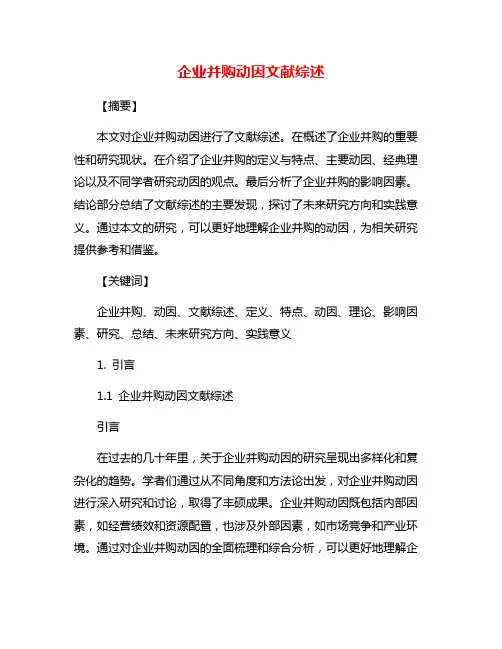
企业并购动因文献综述【摘要】本文对企业并购动因进行了文献综述。
在概述了企业并购的重要性和研究现状。
在介绍了企业并购的定义与特点、主要动因、经典理论以及不同学者研究动因的观点。
最后分析了企业并购的影响因素。
结论部分总结了文献综述的主要发现,探讨了未来研究方向和实践意义。
通过本文的研究,可以更好地理解企业并购的动因,为相关研究提供参考和借鉴。
【关键词】企业并购、动因、文献综述、定义、特点、动因、理论、影响因素、研究、总结、未来研究方向、实践意义1. 引言1.1 企业并购动因文献综述引言在过去的几十年里,关于企业并购动因的研究呈现出多样化和复杂化的趋势。
学者们通过从不同角度和方法论出发,对企业并购动因进行深入研究和讨论,取得了丰硕成果。
企业并购动因既包括内部因素,如经营绩效和资源配置,也涉及外部因素,如市场竞争和产业环境。
通过对企业并购动因的全面梳理和综合分析,可以更好地理解企业并购的逻辑和实质,为企业管理者和决策者提供决策支持和战略指导。
未来的研究方向将更加关注企业并购动因的多样性和复杂性,探讨不同类型企业并购的动因差异和影响机制。
结合实证分析和案例研究,深入挖掘企业并购动因的内在逻辑和外部影响,为企业并购实践和战略制定提供更加有效的建议和指导。
企业并购动因文献综述的意义和价值在于为企业并购研究和实践提供前沿信息和思路,促进学术和商业界的互动与交流,推动企业并购领域的进一步发展和深化。
2. 正文2.1 企业并购的定义与特点企业并购是指一家企业通过收购或合并其他企业来实现快速扩张或实现战略目标的行为。
在当今全球化和竞争激烈的市场环境下,企业并购已成为企业发展的重要战略选择之一。
企业并购具有以下几个特点:1.战略性:企业并购通常是为了实现企业的长期发展战略目标而进行的,可以帮助企业快速进入新的市场、获得核心技术、打造全球化布局等。
2.风险与回报共存:企业并购的过程中存在一定的风险,包括整合风险、文化冲突风险等,但成功的并购也可以为企业带来丰厚的回报。
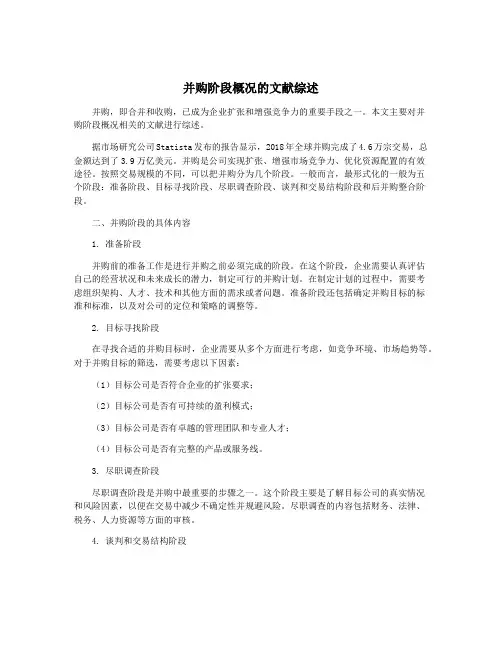
并购阶段概况的文献综述并购,即合并和收购,已成为企业扩张和增强竞争力的重要手段之一。
本文主要对并购阶段概况相关的文献进行综述。
据市场研究公司Statista发布的报告显示,2018年全球并购完成了4.6万宗交易,总金额达到了3.9万亿美元。
并购是公司实现扩张、增强市场竞争力、优化资源配置的有效途径。
按照交易规模的不同,可以把并购分为几个阶段。
一般而言,最形式化的一般为五个阶段:准备阶段、目标寻找阶段、尽职调查阶段、谈判和交易结构阶段和后并购整合阶段。
二、并购阶段的具体内容1. 准备阶段并购前的准备工作是进行并购之前必须完成的阶段。
在这个阶段,企业需要认真评估自己的经营状况和未来成长的潜力,制定可行的并购计划。
在制定计划的过程中,需要考虑组织架构、人才、技术和其他方面的需求或者问题。
准备阶段还包括确定并购目标的标准和标准,以及对公司的定位和策略的调整等。
2. 目标寻找阶段在寻找合适的并购目标时,企业需要从多个方面进行考虑,如竞争环境、市场趋势等。
对于并购目标的筛选,需要考虑以下因素:(1)目标公司是否符合企业的扩张要求;(2)目标公司是否有可持续的盈利模式;(3)目标公司是否有卓越的管理团队和专业人才;(4)目标公司是否有完整的产品或服务线。
3. 尽职调查阶段尽职调查阶段是并购中最重要的步骤之一。
这个阶段主要是了解目标公司的真实情况和风险因素,以便在交易中减少不确定性并规避风险。
尽职调查的内容包括财务、法律、税务、人力资源等方面的审核。
4. 谈判和交易结构阶段在谈判和交易结构阶段,企业需要考虑如何使并购交易达到最佳效果。
交易结构应该合理,并且前期的工作应该充分考虑。
在这个阶段,尤其需要考虑交易的价格问题,并且还需要注意协议表述和保密等事项。
5. 后并购整合阶段后并购整合阶段是实际操作的步骤,企业需要在这个阶段进行组织和平衡。
这包括整合资产和人员、处理有关的贷款、审计和法律问题、合并制度、服务和保留顾客等方面的问题。
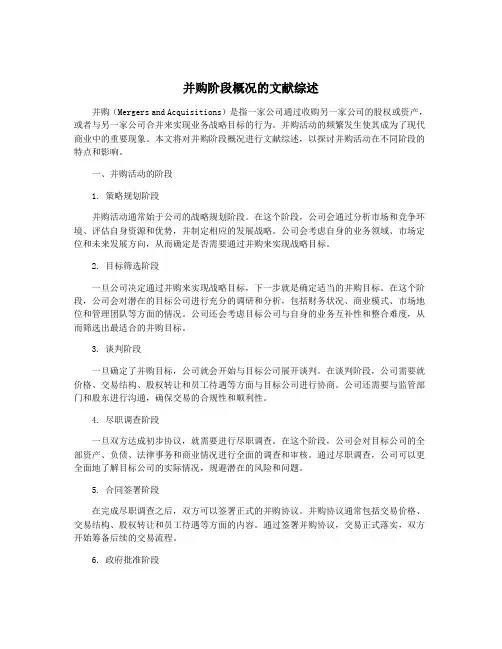
并购阶段概况的文献综述并购(Mergers and Acquisitions)是指一家公司通过收购另一家公司的股权或资产,或者与另一家公司合并来实现业务战略目标的行为。
并购活动的频繁发生使其成为了现代商业中的重要现象。
本文将对并购阶段概况进行文献综述,以探讨并购活动在不同阶段的特点和影响。
一、并购活动的阶段1. 策略规划阶段并购活动通常始于公司的战略规划阶段。
在这个阶段,公司会通过分析市场和竞争环境、评估自身资源和优势,并制定相应的发展战略。
公司会考虑自身的业务领域、市场定位和未来发展方向,从而确定是否需要通过并购来实现战略目标。
2. 目标筛选阶段一旦公司决定通过并购来实现战略目标,下一步就是确定适当的并购目标。
在这个阶段,公司会对潜在的目标公司进行充分的调研和分析,包括财务状况、商业模式、市场地位和管理团队等方面的情况。
公司还会考虑目标公司与自身的业务互补性和整合难度,从而筛选出最适合的并购目标。
3. 谈判阶段一旦确定了并购目标,公司就会开始与目标公司展开谈判。
在谈判阶段,公司需要就价格、交易结构、股权转让和员工待遇等方面与目标公司进行协商。
公司还需要与监管部门和股东进行沟通,确保交易的合规性和顺利性。
4. 尽职调查阶段一旦双方达成初步协议,就需要进行尽职调查。
在这个阶段,公司会对目标公司的全部资产、负债、法律事务和商业情况进行全面的调查和审核。
通过尽职调查,公司可以更全面地了解目标公司的实际情况,规避潜在的风险和问题。
5. 合同签署阶段在完成尽职调查之后,双方可以签署正式的并购协议。
并购协议通常包括交易价格、交易结构、股权转让和员工待遇等方面的内容。
通过签署并购协议,交易正式落实,双方开始筹备后续的交易流程。
6. 政府批准阶段在协议签署之后,公司需要向相关监管部门提交并购申请,并等待政府的批准。
在一些情况下,特别是涉及行业垄断和国家安全的并购案例中,政府可能会对并购进行调查和评估,以确保交易不会对市场和国家利益产生不利影响。
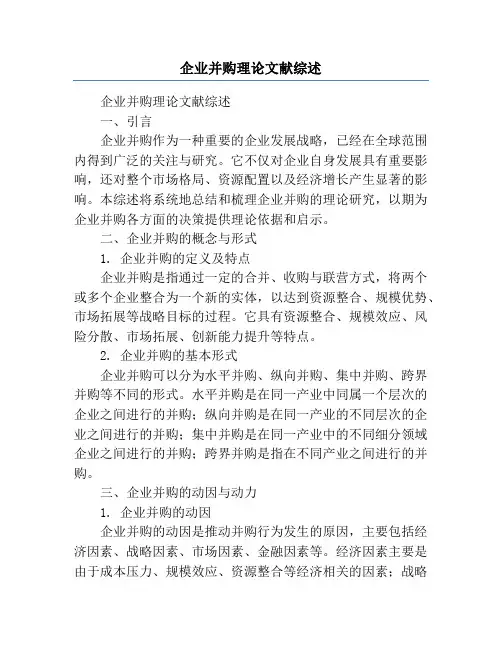
企业并购理论文献综述企业并购理论文献综述一、引言企业并购作为一种重要的企业发展战略,已经在全球范围内得到广泛的关注与研究。
它不仅对企业自身发展具有重要影响,还对整个市场格局、资源配置以及经济增长产生显著的影响。
本综述将系统地总结和梳理企业并购的理论研究,以期为企业并购各方面的决策提供理论依据和启示。
二、企业并购的概念与形式1. 企业并购的定义及特点企业并购是指通过一定的合并、收购与联营方式,将两个或多个企业整合为一个新的实体,以达到资源整合、规模优势、市场拓展等战略目标的过程。
它具有资源整合、规模效应、风险分散、市场拓展、创新能力提升等特点。
2. 企业并购的基本形式企业并购可以分为水平并购、纵向并购、集中并购、跨界并购等不同的形式。
水平并购是在同一产业中同属一个层次的企业之间进行的并购;纵向并购是在同一产业的不同层次的企业之间进行的并购;集中并购是在同一产业中的不同细分领域企业之间进行的并购;跨界并购是指在不同产业之间进行的并购。
三、企业并购的动因与动力1. 企业并购的动因企业并购的动因是推动并购行为发生的原因,主要包括经济因素、战略因素、市场因素、金融因素等。
经济因素主要是由于成本压力、规模效应、资源整合等经济相关的因素;战略因素主要是企业为了实现战略目标、提升核心竞争力等而进行的并购;市场因素主要包括市场变化、市场份额占有、市场拓展等;金融因素主要是包括资本市场的运作和资金融通等。
2. 企业并购的动力企业并购的动力是推动实施并购行为的动力源泉,主要包括资源动力、市场动力、技术动力和运营动力。
资源动力是指企业通过并购获取新的资源,以实现资源整合和规模效应;市场动力是指企业通过并购扩大市场份额,提升市场竞争能力;技术动力是指企业通过并购获取新的技术、知识和专利等,以提升自身技术创新能力;运营动力是指通过并购改善企业运营状况,提高企业效率和盈利能力。
四、企业并购的效应与影响1. 企业并购的效应企业并购对参与者和整个市场都产生了重要的效应。
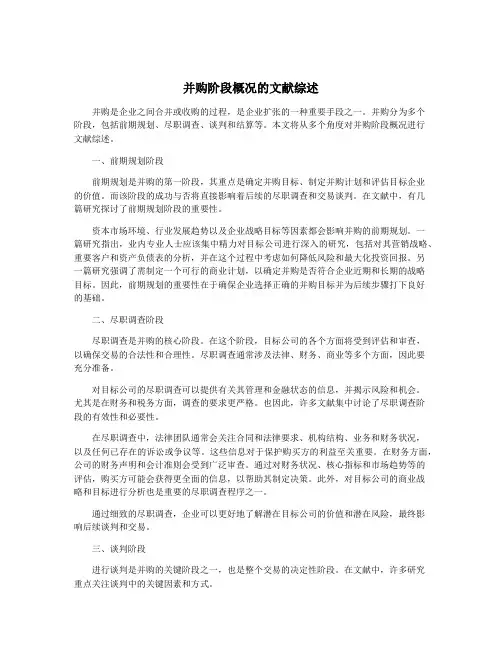
并购阶段概况的文献综述并购是企业之间合并或收购的过程,是企业扩张的一种重要手段之一。
并购分为多个阶段,包括前期规划、尽职调查、谈判和结算等。
本文将从多个角度对并购阶段概况进行文献综述。
一、前期规划阶段前期规划是并购的第一阶段,其重点是确定并购目标、制定并购计划和评估目标企业的价值。
而该阶段的成功与否将直接影响着后续的尽职调查和交易谈判。
在文献中,有几篇研究探讨了前期规划阶段的重要性。
资本市场环境、行业发展趋势以及企业战略目标等因素都会影响并购的前期规划。
一篇研究指出,业内专业人士应该集中精力对目标公司进行深入的研究,包括对其营销战略、重要客户和资产负债表的分析,并在这个过程中考虑如何降低风险和最大化投资回报。
另一篇研究强调了需制定一个可行的商业计划,以确定并购是否符合企业近期和长期的战略目标。
因此,前期规划的重要性在于确保企业选择正确的并购目标并为后续步骤打下良好的基础。
二、尽职调查阶段尽职调查是并购的核心阶段。
在这个阶段,目标公司的各个方面将受到评估和审查,以确保交易的合法性和合理性。
尽职调查通常涉及法律、财务、商业等多个方面,因此要充分准备。
对目标公司的尽职调查可以提供有关其管理和金融状态的信息,并揭示风险和机会。
尤其是在财务和税务方面,调查的要求更严格。
也因此,许多文献集中讨论了尽职调查阶段的有效性和必要性。
在尽职调查中,法律团队通常会关注合同和法律要求、机构结构、业务和财务状况,以及任何已存在的诉讼或争议等。
这些信息对于保护购买方的利益至关重要。
在财务方面,公司的财务声明和会计准则会受到广泛审查。
通过对财务状况、核心指标和市场趋势等的评估,购买方可能会获得更全面的信息,以帮助其制定决策。
此外,对目标公司的商业战略和目标进行分析也是重要的尽职调查程序之一。
通过细致的尽职调查,企业可以更好地了解潜在目标公司的价值和潜在风险,最终影响后续谈判和交易。
三、谈判阶段进行谈判是并购的关键阶段之一,也是整个交易的决定性阶段。
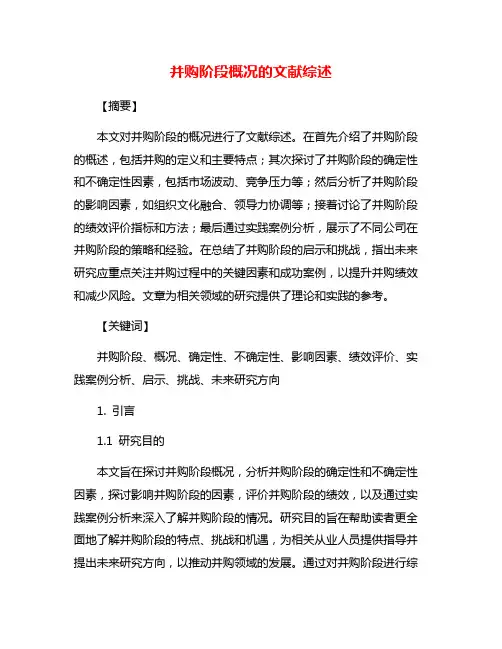
并购阶段概况的文献综述【摘要】本文对并购阶段的概况进行了文献综述。
在首先介绍了并购阶段的概述,包括并购的定义和主要特点;其次探讨了并购阶段的确定性和不确定性因素,包括市场波动、竞争压力等;然后分析了并购阶段的影响因素,如组织文化融合、领导力协调等;接着讨论了并购阶段的绩效评价指标和方法;最后通过实践案例分析,展示了不同公司在并购阶段的策略和经验。
在总结了并购阶段的启示和挑战,指出未来研究应重点关注并购过程中的关键因素和成功案例,以提升并购绩效和减少风险。
文章为相关领域的研究提供了理论和实践的参考。
【关键词】并购阶段、概况、确定性、不确定性、影响因素、绩效评价、实践案例分析、启示、挑战、未来研究方向1. 引言1.1 研究目的本文旨在探讨并购阶段概况,分析并购阶段的确定性和不确定性因素,探讨影响并购阶段的因素,评价并购阶段的绩效,以及通过实践案例分析来深入了解并购阶段的情况。
研究目的旨在帮助读者更全面地了解并购阶段的特点、挑战和机遇,为相关从业人员提供指导并提出未来研究方向,以推动并购领域的发展。
通过对并购阶段进行综述和分析,可为从业人员提供参考,帮助他们更好地应对并购活动中的各种情况,提高并购成功的概率和效率。
本文也旨在促进学术界对并购阶段的研究,拓展对该领域的认识和理解,为未来的研究工作提供借鉴和参考。
1.2 研究意义:并购是当今全球经济中日益普遍的一种商业行为,它在推动企业发展、改善市场结构、提高产业效率等方面发挥着重要作用。
研究并购阶段的概况和相关因素对于加深我们对并购实践的理解,促进并购活动的规范和有效进行具有重要的指导意义。
通过对并购阶段进行深入研究,可以帮助企业更好地把握并购机会,降低并购风险,提升并购绩效,实现企业的长期可持续发展。
本文将对并购阶段的概况进行综合分析,揭示并购阶段的确定性和不确定性因素,探讨并购阶段的影响因素,评价并购阶段的绩效表现,并通过实践案例分析展示并购阶段的具体应用。
新兴市场企业的海外并购:一个文献综述随着全球化的推进,新兴市场企业越来越多地进行海外投资和并购活动。
本文旨在对新兴市场企业海外并购的文献进行综述,并探讨新兴市场企业海外并购的特点、动机和挑战。
1. 控股比例较低相比发达国家企业,新兴市场企业的海外并购更倾向于控股比例较低的收购。
2. 重视区域经济合作新兴市场企业更愿意海外并购邻国或地区的企业。
例如,中国企业对东南亚国家企业的并购比较活跃。
3. 基础设施和资源行业的并购新兴市场企业更多地进行基础设施和资源行业的并购。
例如,中国企业海外并购的主要领域是能源、材料和金融等行业。
1. 扩大市场占有率海外并购是新兴市场企业扩大市场占有率的重要手段。
新兴市场企业通过收购海外企业获得先进技术和管理经验,从而提高其市场竞争力。
2. 获得资源和技术优势新兴市场企业海外并购的重要动机之一是获取资源和技术,提升自身的技术和竞争实力。
3. 提高企业国际化水平新兴市场企业通过海外并购提高企业的国际化水平,进一步扩大企业的全球化布局。
1. 文化差异作为跨国企业,新兴市场企业需要面对文化差异的挑战。
企业需要在跨国文化背景下合理处理各方利益,促进并购的成功。
2. 政策风险新兴市场企业海外并购需要面对不同国家的政策和法律环境。
企业需要了解并遵守当地的法规,以减少政策风险。
3. 资金和人才不足企业海外并购需要消耗大量资金和人才资源,新兴市场企业需要增加资本和人力投入,提高企业的实力。
四、结论新兴市场企业海外并购是企业国际化的重要方式。
新兴市场企业海外并购具有控股比例较低、重视区域经济合作和基础设施和资源行业的并购等特点。
海外并购的动机包括扩大市场占有率、获得资源和技术优势以及提高企业国际化水平。
新兴市场企业海外并购需要面对文化差异、政策风险和资金和人才不足等挑战。
关于跨国公司并购我国企业的文献综述关于跨国公司并购我国企业的文献综述摘要:随着中国入市以及近年来经济的高速增长,跨国公司对我国企业的并购行为日趋活跃。
跨国公司的并购行为无疑能给我国带来一定的积极作用,但同时也产生了一系列负面效应。
本文对一些学者在此问题的探讨上进行综述,对跨国公司并购我国企业的现状、影响和应对措施做简单分析。
关键词:跨国公司;并购;影响Abstract: With China’s accession to the WTO and the recent rapid economic growth, multinational corporations on mergers and acquisitions of enterprises has become increasingly active. This behavior will give multinational companies to bring a positive role in China, but also produced a series of negative effects. In this paper, a number of scholars on this issue were reviewed, on the status of transnational mergers and acquisitions of businesses, and impacts of response measures to do simple analysis. Keywords: Multinational corporation, merger and acquisition, influence 一.引言跨国并购是指跨国公司等国际投资主体通过一定的程序和渠道, 依照东道国法律取得东道国某些现有企业的全部或部分资产所有权的行为[1]。
国内外企业并购研究文献综述近年来,国内外企业并购成为了全球经济领域中的一种重要趋势。
企业并购是指两个或多个公司通过合并或收购来达到资源整合和企业集中的目的。
这种方式可以帮助企业实现规模效益、进一步扩大市场份额、获取新技术和资源等。
企业并购研究的文献综述,可以为我们提供对于这一话题的深入理解,并为未来的研究和实践提供指导。
首先,国内外的研究文献就企业并购的动因进行了广泛的探讨。
Wernerfelt(1984)认为,企业并购的动因主要包括资源获得、市场拓展和技术学习等。
此外,Datta等(1992)提出了企业并购的实施路径,包括同业竞争、新技术入侵和产业逆境等。
对于企业并购的动因研究,可以帮助企业更好地理解并购的目的和动机,从而更好地制定并购策略。
其次,国内外研究文献对于企业并购的影响进行了深入的分析。
Khanna和Yafeh(2024)的研究表明,企业并购可以促进企业绩效的提高和盈利能力的增加。
并且,通过并购可以提高企业的创新能力和竞争力,从而进一步提高企业的市场地位。
此外,Kruse等人(2024)的研究发现,企业并购还可以降低企业的运营成本和提高生产效率。
这些研究结果为企业在进行并购决策时提供了重要的理论依据。
此外,国内外研究文献还对企业并购的风险与挑战进行了详细的讨论。
企业并购的失败可能导致企业财务困境、管理混乱和员工流失等问题。
Seth et al. (2024)的研究发现,文化冲突、组织整合和信息不对称等因素是企业并购失败的主要原因。
此外,Brouthers等人(2024)的研究指出,政治因素、法律环境和经济不确定性等也是企业并购面临的风险和挑战。
对于并购风险与挑战的研究,可以帮助企业更好地评估并购交易的潜在风险,并采取相应的措施来降低风险。
最后,国内外的研究文献对于企业并购的影响因素进行了分析。
企业并购涉及到许多因素,如企业规模、技术水平、行业竞争程度等。
Malmendier和Tate(2024)的研究发现,企业文化和管理团队的素质也对并购的成功与否起到重要作用。
企业连续并购问题研究国内外文献综述一、国外研究现状关于企业并购的相关文献研究,西方国家距今已有着多年历史,并取得了较为全面且具体的研究成果,也随之产生了相对完善的企业并购融资体系。
它包括不同的金融并购融资中介机构、金融工具和管理体系。
在并购融资理论方面,西方还形成了丰富完备的并购融资理论,且取得了较为丰硕的成果。
1983年,Schipper 和Thompson第一次提出了连续并购的概念,Schipper 和Thompson将其定意思为“企业在三年期间内发生三次及三次机上的并购交易”。
在此之后,也有国外研究学者将连续并购分类为短时间内的连续并购与长时间内的连续并购。
前者指的是企业在3-5年内发生不少于5次的并购交易,后者指的是企业每年发生1-2次的并购交易。
Doukas和Petmezas(2007)以及Billett和Qian(2008)发现证据表明,过分自信的高管倾向于进行连续收购,因为他们认为,与“理性”高管相比,这样的连续投资决策最符合股东的利益。
由于过度自信的高管认为他们比别人具有更强的能力。
这种认知偏差激励他们对自己的判断力和从事复杂的任务进行下注,例如连续收购。
过度自信会促使高管人员在企业并购管理中将会明显低估并购风险,高估并购产生的协同作用,因此过度自行的高管可以很乐观并且倾向于快速收购和频繁地定位收购目标。
Croci 和Petmezas(2009)以美国1990年至2002年发生连续并购的591个公司为样本,检验了连续并购的四种潜在动机,即管理层过度自信,卓越收购管理技能,管理者帝国构建动机以及收购是否包含单一计划。
研究发现,成功的收购后续也往往伴随着成功的收购。
这种表现的持久性表明,出色的管理技能可能是进行连续收购的重要原因。
过度自信不会驱使胜利者的连续并购,管理者帝国构建动机也不会驱使连续并购,连续并购也不是并购公司整个收购计划的结果,只有管理层卓越的收购管理技能促使了公司连续并购活动。
文献综述摘要近些年来,随着市场经济不断地发展,公司并购己经成为公司发展的一种趋势。
企业并购是一种优化资源配置的过程,是企业成长的一种重要方式。
通过对资产的合并重组来实现企业价值最大化,从而提高企业经营绩效,扩大经营规模,降低平均成本,实现“协同效益”。
本文将结合并购绩效的理论知识,以及并购绩效的研究方法,通过搜集国内外文献资料,探讨企业并购前后的绩效变化,分析并购绩效的影响因素并采取有效措施来提高公司绩效。
关键词:并购并购绩效协同效应前言并购是促进产业结构优化升级的重要途径,可以给企业带来生产和经营上的规模经济,扩大协同效应,节约交易成本,增强企业的市场控制力与竞争力。
纵观国外大企业的发展历史,做大做强除了要靠企业自身的积累外,最重要的是靠并购重组。
国务院《关于十大产业调整振兴规划》中,有9 个产业明确提出要扶持大企业、支持并购重组,这必将引起国内企业新的并购浪潮。
根据投中集团旗下数据产品C V Source 统计显示,2006 年至今,中国并购市场的交易完成规模明显呈现逐年上升趋势,从2006 年的1434.8 亿元上升至2010 年的6921.52 亿元。
在并购市场如火如荼发展的同时,我们也要注意到企业并购是一把双刃剑,既蕴含着机遇又富有挑战。
研究并购绩效,总结以往并购案中的经验与教训,对以后的并购有借鉴意义。
一、并购相关概念(一)并购实践中的公司并购活动不断创新,人们对并购概念的认识难以统一。
一般来说并购概念有广义和狭义之分。
狭义的并购《中华人民共和国公司法》第184条规定的公司合并,分为吸收合并和新设合并两种方式。
一个公司吸收其他公司为吸收合并(Merger),被吸收的公司解散,也称为兼并。
根据权威性的《大不列颠百科全书》兼并(Merger)一词的解释是:“指两家或更多的独立企业、公司合并组成一家企业,通常由一家占优势的公司吸收一家或更多公司。
兼并的方法:(1)用现金或证券购买其他公司的资产;(2)购买其他公司的股份或股票;(3)对其他公司股东发型新股票以换取其所持有的股权,从而取得其他公司的资产和负债。